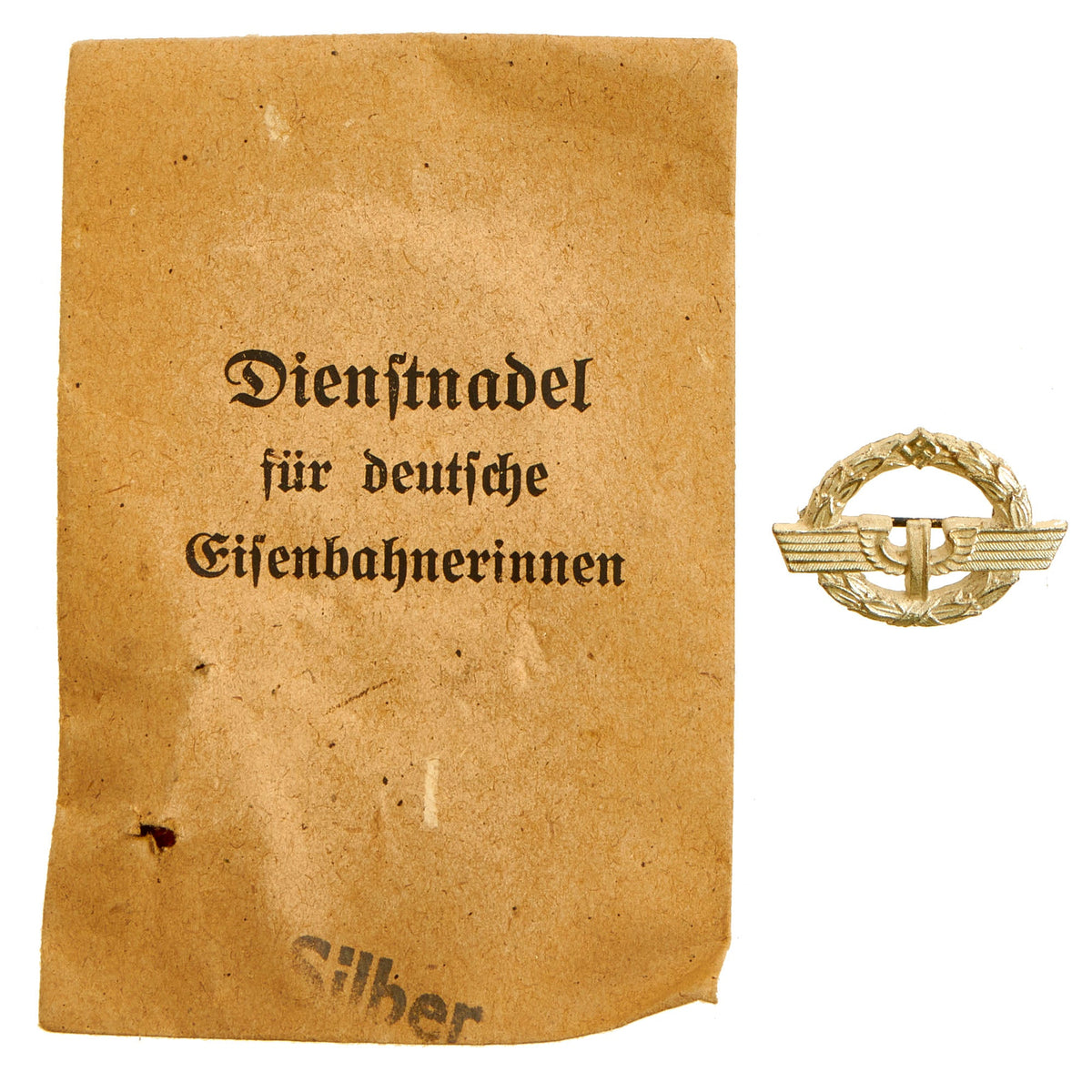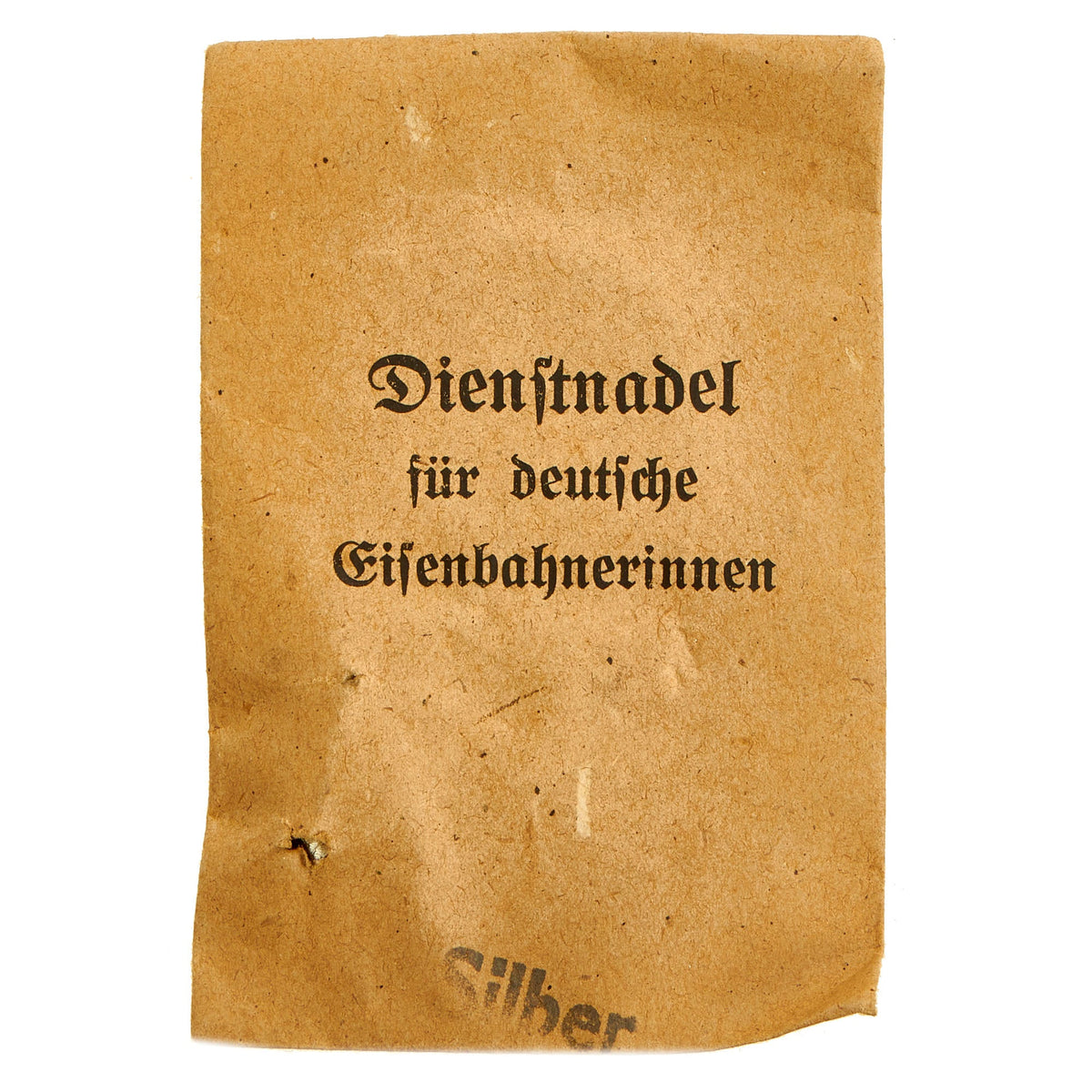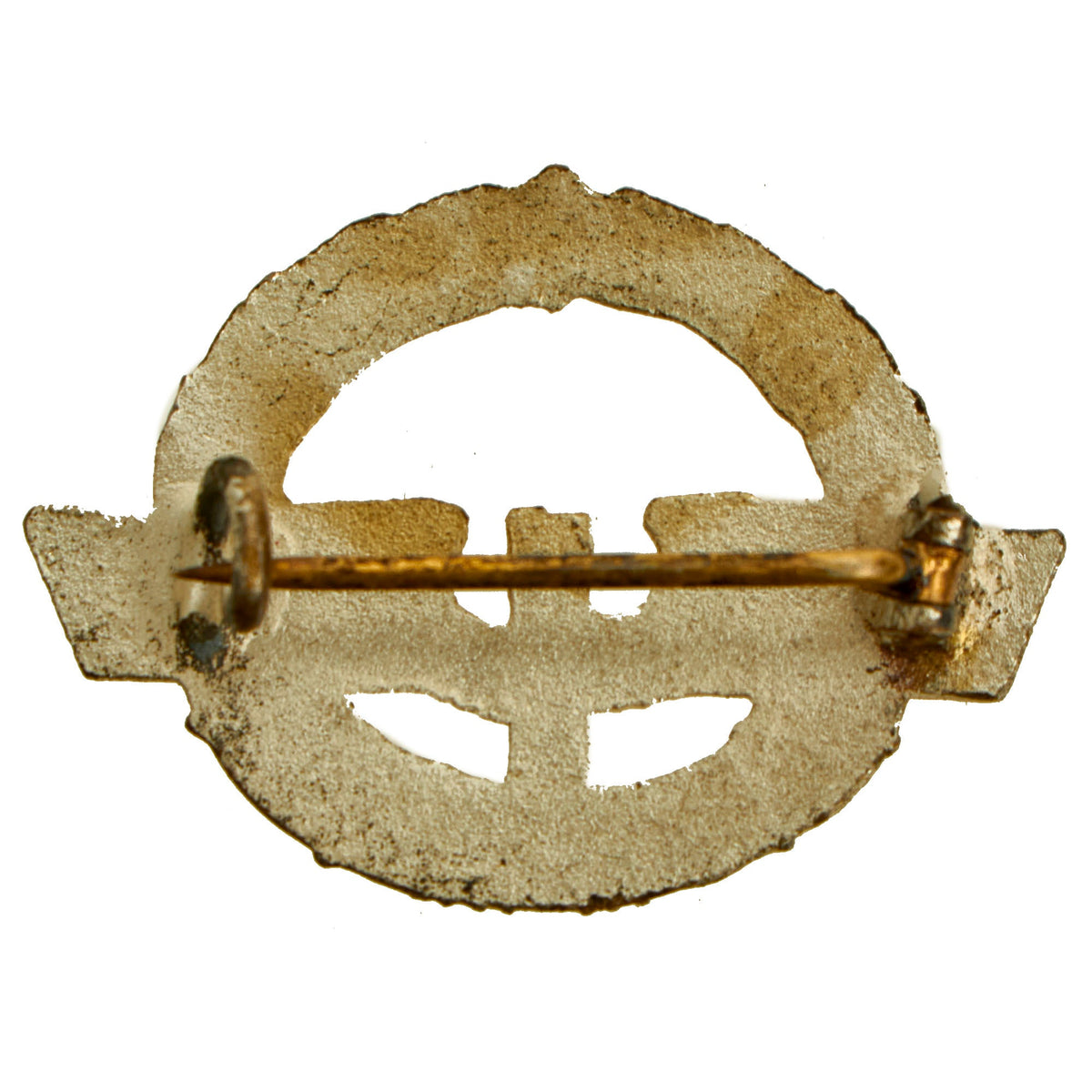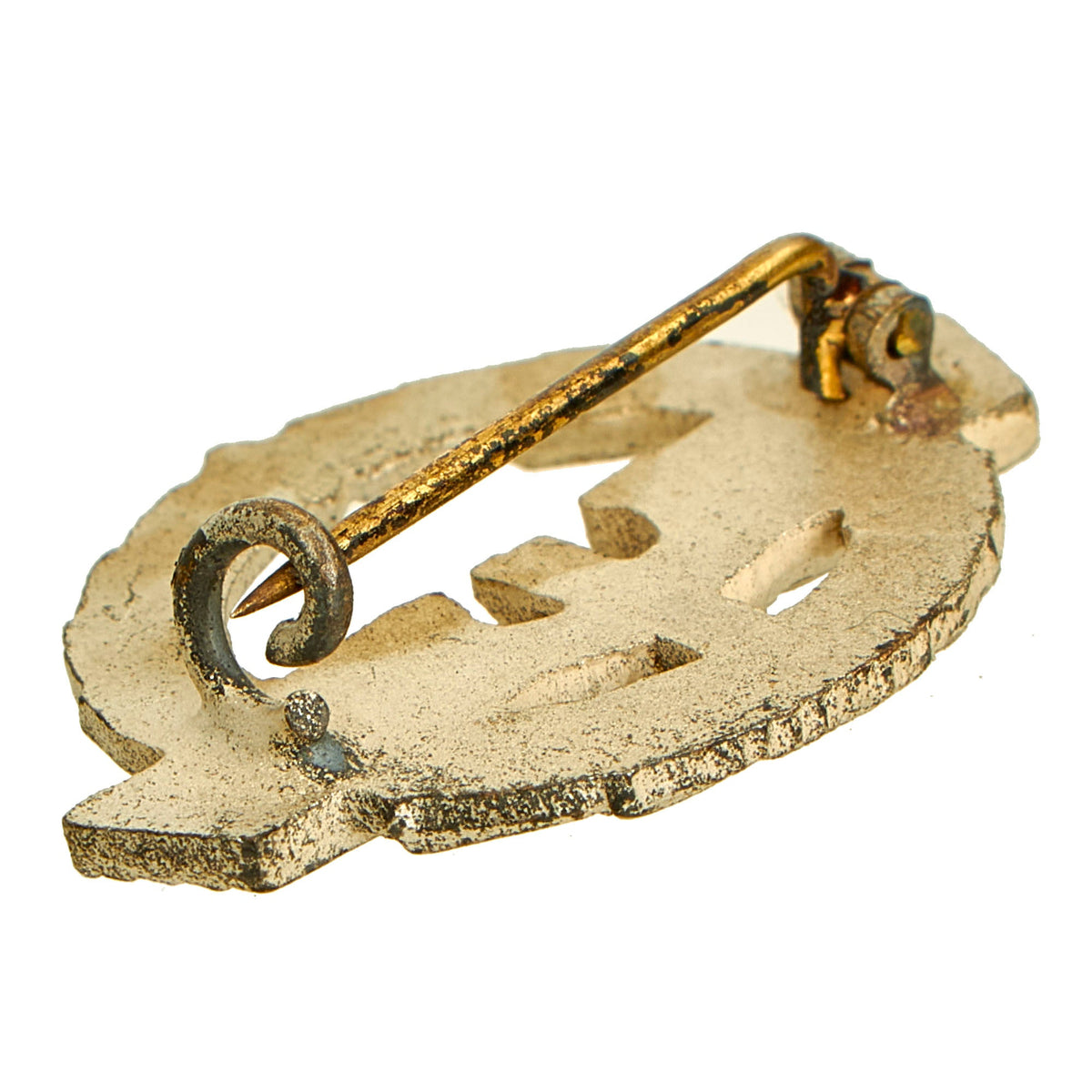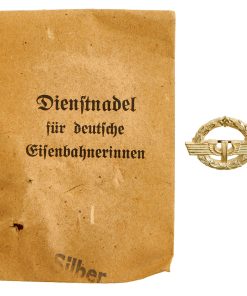Original German WWII Deutsches Reichsbahn National Railway Silver Grade Female Staff Service Badge in Paper Packet Original Items
$ 495,00 $ 148,50
Original Item: Only One Available. This is a rare, genuine Deutsche Reichsbahn (German National Railway) Silver Grade Female Staff Badge, still in the original paper packet! These awards were instituted in 1944, and were awarded in three grades based on how long the female staff member had been in service. The gold award was for 10 years of active service, the silver for 6, and the bronze for 3. The design is a small pin with the DRB “Winged Wheel” insignia in the middle, with a laurel wreath surrounding it with a Swas (hook cross) at the top.
This example is textbook, measuring approximately 30mm wide by 20mm tall, and still has almost all of the silvering on the front still bright, with a functional pinback. The included original paper packet has the correct information stamped on the front in German “black letter” type face:
Dienſtnadel
für deutſche
Eiſenbahnerinnen
This translates literally to “Service badge for German railway workers”, and there is also the word Silber (Silver) stamped towards the bottom. The packet is made from brown unbleached paper, very common for WWII issued awards.
Ready to add to your German WWII collection!
Deutsche Reichsbahn (1937 to 1945)
With the Act for the New Regulation of the Conditions of the Reichsbank and the Deutsche Reichsbahn (Gesetz zur Neuregelung der Verhältnisse der Reichsbank und der Deutschen Reichsbahn) of 10 February 1937 the Deutsche Reichsbahn Gesellschaft was placed under Reich sovereignty and was given the name Deutsche Reichsbahn.
World War II and military use
The Reichsbahn had an important logistic role in supporting the rapid movement of the troops of the Wehrmacht, for example:
In all the occupied lands the Reichsbahn endeavored to incorporate the captured railways (rolling stock and infrastructure) into their system. Even towards the end of the war the Reichsbahn continued to move military formations. For example, in the last great offensive, the Battle of the Bulge (from 16 December 1944), tank formations were transported from Hungary to the Ardennes.
The railways managed by the “Eastern Railway Division” (Generaldirektion der Ostbahn) were initially run from that part of the Polish State Railways within the so-called General Government gelegene Teil der Polnischen Staatsbahnen (PKP), but from November 1939 by the Ostbahn (Generalgouvernement).
In the campaigns against Poland, Denmark, France, Yugoslavia, Greece etc. the newly acquired standard gauge networks could be used without difficulty. By contrast, after the start of the invasion of Russia on 22 June 1941, the problem arose of transferring troops and materiel to Soviet broad gauge lines or converting them to German standard gauge. Confounding German plans, the Red Army and Soviet railways managed to withdraw or destroy the majority of its rolling stock during its retreat. As a result, German standard gauge rolling stock had to be used for an additional logistic role within Russia; this required the laying of standard gauge track. The price was high: Reichsbahn railway staff and the railway troops of the Wehrmacht had to convert a total of 16,148 kilometres of Soviet trackage to German standard gauge track between 22 June and 8 October 1941.
During the war, locomotives in the war zones were sometimes given camouflage livery. In addition, locomotives were painted with the Hoheitsadler symbol (the eagle, Germany’s traditional symbol of national sovereignty) holding a swas. On goods wagons the name “Deutsche Reichsbahn” was replaced by the letters “DR”. Postal coaches continued to bear the name “Deutsche Reichspost”.
The logistics of the Reichsbahn were crucial to the conduct of Germany’s military offensives. The preparations for the invasion of Russia saw the greatest troop deployment by rail in history.
Expansion
Characteristic of the first six and a half years of this period was the exponential growth of the Deutsche Reichsbahn, which was almost exclusively due to the takeover of other national railways. This affected both parts of foreign state railways (in Austria the entire state railway) in the countries annexed by the Deutsche Reich, as well as private railways in Germany and in other countries:
The logistics of the Reichsbahn were also an important factor during the Shoah. Jews were transported like cattle to the contingent and extermination camps by the Deutsche Reichsbahn in trains of covered goods wagons, so-called Shoah trains. These movements using cattle wagons, for example, from the goods station of the great Frankfurt Market Hall thus played a significant role in the genocide within the extermination machinery of the Shoah.
Breakup of the Reichsbahn
With the end of the Second World War in 1945 those parts of the Deutsche Reichsbahn that were outside the new German borders laid down in the Potsdam Agreement were transferred to the ownership and administration of the states in whose territory they were situated. For example, on 27 April 1945, the Austrian railways became independent again as the Austrian State Railway (Österreichische Staatseisenbahn or ÖStB), later renamed as the Austrian Federal Railways (Österreichische Bundesbahnen or ÖBB) on 5 August 1947.
Fast Shipping with Professional Packaging
Thanks to our longstanding association with UPS FedEx DHL, and other major international carriers, we are able to provide a range of shipping options. Our warehouse staff is expertly trained and will wrap your products according to our exact and precise specifications. Prior to shipping, your goods will be thoroughly examined and securely secured. We ship to thousands clients each day across multiple countries. This shows how we're dedicated to be the largest retailer on the internet. Warehouses and distribution centres can be located throughout Europe as well as the USA.
Note: Orders with more than one item will be assigned a processing date depending on the item.
Before shipping before shipping, we'll conduct a thorough inspection of the items you have ordered. Today, the majority of orders will be delivered within 48 hours. The delivery time will be between 3-7 days.
Returns
The stock is dynamic and we cannot completely manage it because multiple stakeholders are involved, including our factory and warehouse. So the actual stock may alter at any time. It's possible that you may not receive your order once the order has been made.
Our policy is valid for a period of 30 days. If you don't receive the product within 30 days, we are not able to issue a refund or an exchange.
You can only return an item if it is unused and in the same state as the day you received it. You must have the item in its original packaging.
Related products
Uncategorized
Band of Brothers ORIGINAL GERMAN WWII Le. F.H. 18 10.5cm ARTILLERY PIECE Original Items
Uncategorized
Uncategorized
Armoured Fighting Vehicles of the World: AFVs of World War One (Hardcover Book) New Made Items
Uncategorized
Uncategorized
Uncategorized
Uncategorized
Uncategorized
Uncategorized
Uncategorized
Uncategorized
Uncategorized
Uncategorized
Uncategorized
Uncategorized
Australian WWII Owen MK1 Machine Carbine SMG Custom Fabricated Replica with Sling Original Items
Uncategorized
Uncategorized
Uncategorized
Uncategorized
Uncategorized
